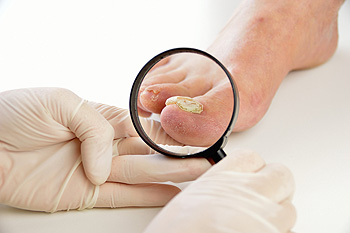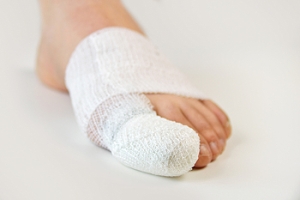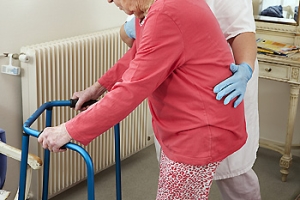
What Is a Stubbed Toe?
A stubbed toe occurs when the toe is injured by suddenly hitting or jamming it. This can happen when you hit your toe against a piece of furniture, trip over something, or catch your toe on an object. Stubbed toes typically cause intense pain that radiates to other parts of the foot or ankle and increases when you put weight on the toe. Stubbed toes may result in more serious injuries, such as a toe sprain, fracture, bone bruise, or an injury to the toenail. If you have stubbed your toe and notice that it is very painful and swollen, or that the injury makes it difficult to put weight on the foot or walk, it is recommended that you see a podiatrist.
Broken toes may cause a lot of pain and should be treated as soon as possible. If you have any concerns about your feet, contact Jordan S. Steinberg, DPM from Florham Park Podiatry . Our doctor will treat your foot and ankle needs.
What Is a Broken Toe?
A broken toe occurs when one or more of the toe bones of the foot are broken after an injury. Injuries such as stubbing your toe or dropping a heavy object on it may cause a toe fracture.
Symptoms of a Broken Toe
- Swelling
- Pain (with/without wearing shoes)
- Stiffness
- Nail Injury
Although the injured toe should be monitored daily, it is especially important to have a podiatrist look at your toe if you have severe symptoms. Some of these symptoms include worsening or new pain that is not relieved with medication, sores, redness, or open wounds near the toe.
If you have any questions, please feel free to contact our office located in Florham Park, NJ . We offer the newest diagnostic and treatment technologies for all your foot care needs.
What to Know About a Broken Toe
Trauma to the foot, especially the toes, can occur in many ways. Banging them, stubbing them, or dropping something on them are a few different ways this trauma can occur. Given the fact that toes are positioned in front of the feet, they typically sustain the brunt of such trauma. When trauma occurs to a toe, the result can be a painful break or fracture. Another type of trauma that can break a toe is repeated activity that places stress on the toe for prolonged periods of time.
Broken toes can be categorized as either minor or severe fractures. Symptoms of minor toe fractures include throbbing pain, swelling, bruising on the skin and toenail, and the inability to move the toe with ease. Severe toe fractures require medical attention and are indicated when the broken toe appears crooked or disfigured, when there is tingling or numbness in the toe, or when there is an open, bleeding wound present on the toe.
Generally, a minor toe break will heal without long-term complications. However, it is important to discontinue activities that put pressure on the toe. It is best to stay off of the injured toe and immediately get a splint or cast to prevent any more additional movement of the toe bones. You can also immobilize your toe by placing a small cotton ball between the injured toe and the toe beside it. Then, tape the two toes together with medical tape. Swelling can be alleviated by placing an ice pack on the broken toe directly as well as elevating your feet above your head.
Severe toe fractures may be treated with a splint, cast, and in some cases, minor surgery, especially when the big toe has been broken. Due to its position and the pressure the big toe endures with daily activity, future complications can occur if it is not properly treated. Pain associated with minor toe fractures can be managed with over-the-counter pain medications. Prescription pain killers may be necessary for severe toe fractures.
The healing time for a broken toe is approximately four to six weeks. In severe cases where the toe becomes infected or requires surgery, healing time can take up to eight weeks or more. While complications associated with a broken toe are immediately apparent, it is important to note that there are rare cases when additional complications, such as osteoarthritis, can develop over time. You should immediately speak with your podiatrist if you think you have broken your toe due to trauma. They will be able to diagnose the injury and recommend the appropriate treatment options.
Falling Can Injure The Feet
 The number of falls that occur in elderly people worldwide increases every year. Research has indicated this may lead to foot injuries that can make it difficult to complete every day activities. Many falls happen in the home, and there are methods that can be implemented that can help to prevent falling. These can include removing worn rugs from the living area, and improving lighting in the household. Additionally, it is helpful to receive annual physical examinations in which existing medications are reviewed. Many patients find it helpful to install grab bars in the toilet and shower area, and falls may be minimized when a bathmat is placed on the shower floor. Please review fall prevention techniques with a podiatrist who can help you to prevent painful foot injuries.
The number of falls that occur in elderly people worldwide increases every year. Research has indicated this may lead to foot injuries that can make it difficult to complete every day activities. Many falls happen in the home, and there are methods that can be implemented that can help to prevent falling. These can include removing worn rugs from the living area, and improving lighting in the household. Additionally, it is helpful to receive annual physical examinations in which existing medications are reviewed. Many patients find it helpful to install grab bars in the toilet and shower area, and falls may be minimized when a bathmat is placed on the shower floor. Please review fall prevention techniques with a podiatrist who can help you to prevent painful foot injuries.
Preventing falls among the elderly is very important. If you are older and have fallen or fear that you are prone to falling, consult with Jordan S. Steinberg, DPM from Florham Park Podiatry . Our doctor will assess your condition and provide you with quality advice and care.
Every 11 seconds, an elderly American is being treated in an emergency room for a fall related injury. Falls are the leading cause of head and hip injuries for those 65 and older. Due to decreases in strength, balance, senses, and lack of awareness, elderly persons are very susceptible to falling. Thankfully, there are a number of things older persons can do to prevent falls.
How to Prevent Falls
Some effective methods that older persons can do to prevent falls include:
- Enrolling in strength and balance exercise program to increase balance and strength
- Periodically having your sight and hearing checked
- Discuss any medications you have with a doctor to see if it increases the risk of falling
- Clearing the house of falling hazards and installing devices like grab bars and railings
- Utilizing a walker or cane
- Wearing shoes that provide good support and cushioning
- Talking to family members about falling and increasing awareness
Falling can be a traumatic and embarrassing experience for elderly persons; this can make them less willing to leave the house, and less willing to talk to someone about their fears of falling. Doing such things, however, will increase the likelihood of tripping or losing one’s balance. Knowing the causes of falling and how to prevent them is the best way to mitigate the risk of serious injury.
If you have any questions, please feel free to contact our office located in Florham Park, NJ . We offer the newest diagnostic and treatment technologies for all your foot care needs.
Falls Prevention
Elderly Americans are very susceptible to falls as they get older. Everyone experiences decreases in flexibility, balance, strength, and the senses as they age. This correlates to some eye-opening statistics. 1 in 4 Americans aged 65 and older fall each year. An elderly American is being treated for a fall in an emergency room every 11 seconds. In light of these striking statistics, one can see the importance of taking steps to prevent falls.
Finding an exercise program for the elderly is an excellent way to reduce the likelihood of falls. Look for an exercise program that improves strength and balance. Elderly people who live a more sedentary lifestyle, with little physical activity, are at an increased risk of falling. Wearing well-fitted footwear that provides good foot support and cushion will help prevent falls from poorly fitted shoes. Talking to a podiatrist about your susceptibility to falls and about inspecting your prescriptions will help to avoid any medication that could make falls more likely. Due to a decline in the senses among the elderly, having your eyes and hearing checked is recommended.
Around half of all falls occur in the household. Removing tripping hazards in the home and making it more accommodating to older persons can significantly reduce falls. Some notable household changes include increasing lighting around the house, installing grab bars in the shower and bathroom, and making sure the floor is clear of clutter. Other smart options include installing a shower chair, using rubber-bottomed rugs, and placing railings on both sides of stairwells.
Finally, discuss with a doctor and your family about your fear of falling. This will help to increase awareness among the population on the need for fall prevention. A lack of awareness on the matter, and a downplaying of importance are what increase the risks of falling. Following these tips can help to reduce the risk for yourself and your loved ones.
When Should I See a Foot and Ankle Surgeon?
 Most injuries and diseases of the foot and ankle are not treated surgically. However, a foot and ankle surgeon can still help you by examining your feet and ankles when you experience pain or other symptoms of injury or disease. You may want to consult a foot and ankle surgeon if you have sustained an injury, such as a sprain or fracture, have a medical condition that can affect the feet, have difficulty completing daily activities, or notice a change in the appearance of your feet or ankles. Foot and ankle surgeons tend to only suggest surgery when a problem is severe and non-surgical treatments have failed. For more information about how a foot and ankle surgeon may be able to help you, please consult with a podiatrist.
Most injuries and diseases of the foot and ankle are not treated surgically. However, a foot and ankle surgeon can still help you by examining your feet and ankles when you experience pain or other symptoms of injury or disease. You may want to consult a foot and ankle surgeon if you have sustained an injury, such as a sprain or fracture, have a medical condition that can affect the feet, have difficulty completing daily activities, or notice a change in the appearance of your feet or ankles. Foot and ankle surgeons tend to only suggest surgery when a problem is severe and non-surgical treatments have failed. For more information about how a foot and ankle surgeon may be able to help you, please consult with a podiatrist.
Foot surgery is sometimes necessary to treat a foot ailment. To learn more, contact Jordan S. Steinberg, DPM of Florham Park Podiatry . Our doctor will assist you with all of your foot and ankle needs.
When Is Surgery Necessary?
Foot and ankle surgery is generally reserved for cases in which less invasive, conservative procedures have failed to alleviate the problem. Some of the cases in which surgery may be necessary include:
- Removing foot deformities like bunions and bone spurs
- Severe arthritis that has caused bone issues
- Cosmetic reconstruction
What Types of Surgery Are There?
The type of surgery you receive will depend on the nature of the problem you have. Some of the possible surgeries include:
- Bunionectomy for painful bunions
- Surgical fusion for realignment of bones
- Neuropathy decompression surgery to treat nerve damage
Benefits of Surgery
Although surgery is usually a last resort, it can provide more complete pain relief compared to non-surgical methods and may allow you to finally resume full activity.
Surgical techniques have also become increasingly sophisticated. Techniques like endoscopic surgery allow for smaller incisions and faster recovery times.
If you have any questions please feel free to contact our office located in Florham Park, NJ . We offer the newest diagnostic and treatment technologies for all your foot and ankle needs.
Foot Surgery
In most cases, foot surgery is often chosen as the last available option for conditions that have otherwise been unsuccessfully treated. Surgery may be necessary for several reasons, including the removal of foot deformities (e.g. bone spurs or bunions), arthritis problems, reconstruction due to injury, and congenital malformations (e.g. club foot or flat feet). Regardless of one’s age, foot surgery may be the only successful option for treatment for certain conditions.
The type of surgery one undergoes depends on the type of foot condition the patient has. For the removal of a bunion growth, a bunionectomy is necessary. If the bones in the feet need to be realigned or fused together, a surgical fusion of the foot is needed. For pain or nerve issues, a patient may require surgery in which the tissues surrounding the painful nerve are removed. Initially, less invasive treatments are generally attempted; surgery is often the last measure taken if other treatments are unsuccessful.
While in many cases surgery is often deemed as the final resort, choosing surgery comes with certain benefits. The associated pain experienced in relation to the particular condition is often relieved with surgery, allowing patients to quickly resume daily activities. The greatest benefit, however, is that surgery generally eliminates the problem immediately.
Podiatry history has shown that foot treatments continue to evolve over time. In the field of foot surgery, endoscopic surgery is just one of the many advanced forms of surgery. As technology vastly improves so too will the various techniques in foot surgery, which already require smaller and smaller incisions with the use of better and more efficient tools. Thanks to such innovations, surgery is no longer as invasive as it was in the past, allowing for faster and easier recoveries.
How Diabetes Impacts the Feet
 The medical condition that is known as diabetes is considered to be a metabolic disorder. This is a disease that gradually develops as a result of elevated blood sugar levels, and generally falls into two categories. Type 1 diabetes is known to be an autoimmune disorder, and may appear in early childhood. Obesity may be a contributing factor in developing type 2 diabetes, and in many patients, occurs after the age of forty. High blood sugar levels may cause a loss of sensation in the feet, and it can become difficult to feel existing cuts and foot wounds. Diabetic patients may find it helpful to perform daily foot checks, and this can be beneficial to noticing any cuts or bruises that are present. If you have diabetes, it is strongly suggested that you are under the care of a podiatrist who can help you to manage this condition.
The medical condition that is known as diabetes is considered to be a metabolic disorder. This is a disease that gradually develops as a result of elevated blood sugar levels, and generally falls into two categories. Type 1 diabetes is known to be an autoimmune disorder, and may appear in early childhood. Obesity may be a contributing factor in developing type 2 diabetes, and in many patients, occurs after the age of forty. High blood sugar levels may cause a loss of sensation in the feet, and it can become difficult to feel existing cuts and foot wounds. Diabetic patients may find it helpful to perform daily foot checks, and this can be beneficial to noticing any cuts or bruises that are present. If you have diabetes, it is strongly suggested that you are under the care of a podiatrist who can help you to manage this condition.
Diabetic foot care is important in preventing foot ailments such as ulcers. If you are suffering from diabetes or have any other concerns about your feet, contact Jordan S. Steinberg, DPM from Florham Park Podiatry . Our doctor can provide the care you need to keep you pain-free and on your feet.
Diabetic Foot Care
Diabetes affects millions of people every year. The condition can damage blood vessels in many parts of the body, especially the feet. Because of this, taking care of your feet is essential if you have diabetes, and having a podiatrist help monitor your foot health is highly recommended.
The Importance of Caring for Your Feet
- Routinely inspect your feet for bruises or sores.
- Wear socks that fit your feet comfortably.
- Wear comfortable shoes that provide adequate support.
Patients with diabetes should have their doctor monitor their blood levels, as blood sugar levels play such a huge role in diabetic care. Monitoring these levels on a regular basis is highly advised.
It is always best to inform your healthcare professional of any concerns you may have regarding your feet, especially for diabetic patients. Early treatment and routine foot examinations are keys to maintaining proper health, especially because severe complications can arise if proper treatment is not applied.
If you have any questions please feel free to contact our office located in Florham Park, NJ . We offer the newest diagnostic and treatment technologies for all your foot and ankle needs.
Diabetic Foot Conditions
Diabetes is the condition in which the body does not properly process food for use as energy. People with Type 1 diabetes cannot produce insulin, which is required for glucose to feed your body’s cells. It is typically caused by the immune system mistaking healthy cells for foreign invaders and destroying the insulin-producing cells in the pancreas. On the other hand, people with Type 2 diabetes cannot respond to insulin properly, and eventually cannot produce enough. The Centers for Disease Control and Prevention reports that over 30 million people in the United States have diabetes, with 1 in 4 having no idea they have it. Surprisingly, diabetes is the seventh leading cause of death in the US. The symptoms of diabetes include frequent urination, fatigue, hunger, and even blurry vision.
Diabetes can also affect the feet as well. Over time, diabetes can cause nerve damage to your feet, which could then lead to symptoms such as tingling, pain and numbness in the feet. Neuropathy can be very dangerous to a person with diabetes, since it prevents them from feeling injuries such as cuts or blisters in the feet, and if not detected early enough, may lead to infection. Neuropathy can also lead changes in the shape of your feet and toes. The best way for people with diabetes to prevent or delay neuropathy is keeping their blood glucose levels in their target range. This consists of eating right, having the correct amount of exercise, and taking medications.
Diabetes can also create calluses and foot ulcers as well. Calluses build up faster and occur more frequently with those affected by diabetes. If there are too many calluses, therapeutic shoes and inserts may be required. It is important to have calluses trimmed by a health professional, as doing it yourself may lead to infections. If these calluses continue to develop and thicken, they can lead to foot ulcers. Foot ulcers are open sores, that appear on the ball of the foot or on the bottom of the big toe. These ulcers can lead to future infections if not treated and may possibly result in losing a limb. It is important to report any ulcers to your podiatrist right away. Your doctor may take x-rays to examine the foot and clean out any dead and infected tissue.
Lastly, diabetes can also lead to poor circulation and peripheral arterial disease (PAD). The poor circulation in the feet and leg area is a result of diabetes narrowing and hardening, eventually slowing down the blood flow in that area. The best way to prevent this is to keep away from smoking and follow your doctor’s advice for maintaining blood pressure and cholesterol. PAD is similar to this complication. PAD is when blood vessels narrow or are blocked by fatty deposits. PAD also increases your risk of heart attacks and strokes and is a common condition to those affected by diabetes. The combination of both PAD and neuropathy may lead to infections and can result in amputation of certain limbs. PAD can be prevented with wearing the proper foot wear and regularly taking care of your feet.
If you want to take care of your feet, you should wash and dry them carefully and perform daily inspections to check for cuts, blisters, or swelling. Any physical activity you partake in should be approved by your health care provider. You should also be sure to wear special shoes if advised to do so by your doctor.
Ways to Prevent Toenail Fungus
 Toenail infections are a common problem that occurs when a fungus begins to grow under the nail. Upon infection, the toenail can turn yellow, become crumbly, thicken, and separate from the nail bed. Because the fungi that cause these infections thrive in warm and moist environments, there are a few key ways to prevent a fungal nail infection. These methods include ensuring that the feet are properly dried, keeping the toenails short, wearing clean socks, wearing footwear in public pools and showers, not sharing footwear with others, and using an antifungal spray in your shoes. If you still get an infection, there are a variety of treatment options that a podiatrist can provide. A podiatrist can prescribe antifungal medicines, remove the infected nail, or use an antifungal nail polish. If you believe that you have a fungal nail infection, visiting a podiatrist is recommended.
Toenail infections are a common problem that occurs when a fungus begins to grow under the nail. Upon infection, the toenail can turn yellow, become crumbly, thicken, and separate from the nail bed. Because the fungi that cause these infections thrive in warm and moist environments, there are a few key ways to prevent a fungal nail infection. These methods include ensuring that the feet are properly dried, keeping the toenails short, wearing clean socks, wearing footwear in public pools and showers, not sharing footwear with others, and using an antifungal spray in your shoes. If you still get an infection, there are a variety of treatment options that a podiatrist can provide. A podiatrist can prescribe antifungal medicines, remove the infected nail, or use an antifungal nail polish. If you believe that you have a fungal nail infection, visiting a podiatrist is recommended.
If left untreated, toenail fungus may spread to other toenails, skin, or even fingernails. If you suspect you have toenail fungus it is important to seek treatment right away. For more information about treatment, contact Jordan S. Steinberg, DPM of Florham Park Podiatry . Our doctor can provide the care you need to keep you pain-free and on your feet.
Symptoms
- Warped or oddly shaped nails
- Yellowish nails
- Loose/separated nail
- Buildup of bits and pieces of nail fragments under the nail
- Brittle, broken, thickened nail
Treatment
If self-care strategies and over-the-counter medications does not help your fungus, your podiatrist may give you a prescription drug instead. Even if you find relief from your toenail fungus symptoms, you may experience a repeat infection in the future.
Prevention
In order to prevent getting toenail fungus in the future, you should always make sure to wash your feet with soap and water. After washing, it is important to dry your feet thoroughly especially in between the toes. When trimming your toenails, be sure to trim straight across instead of in a rounded shape. It is crucial not to cover up discolored nails with nail polish because that will prevent your nail from being able to “breathe”.
In some cases, surgical procedure may be needed to remove the toenail fungus. Consult with your podiatrist about the best treatment options for your case of toenail fungus.
If you have any questions, please feel free to contact our office located in Florham Park, NJ . We offer the newest diagnostic and treatment technologies for all your foot care needs.








